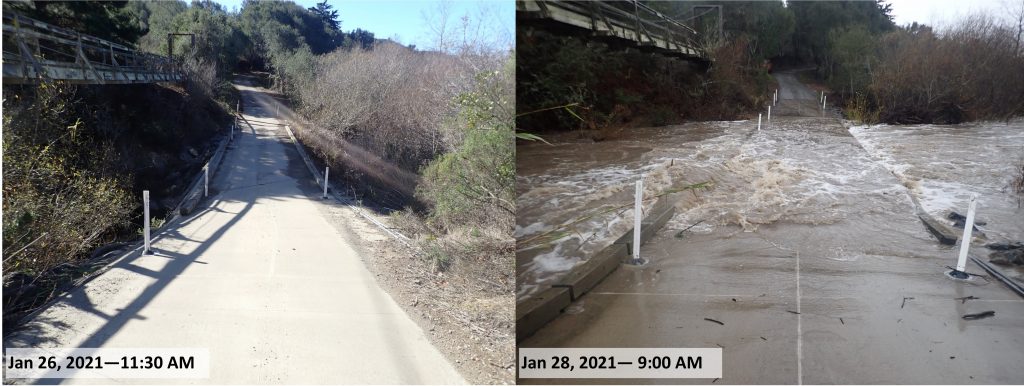COVID-19 Precautions
The Morro Bay National Estuary Program’s fieldwork has been deemed an essential service by the County of San Luis Obispo. Due to COVID-19 safety precautions, we are not working with volunteers at this time and our field staff are following updated monitoring protocols. We look forward to working with volunteers and other community members again as soon as it is safe for us to do so. Thank you, readers, for staying engaged and supporting the Estuary Program’s work on storm monitoring and other fieldwork tasks during this difficult time.
Monitoring Sites Post-Storm
January brought a substantial amount of much-needed rainfall during the latter part of the month, creating large, sediment-moving flows. Between January 22nd and January 29th, 2021, a rain gage located at Canet Road recorded a whopping 8.19 inches of rainfall. For comparison, this same rain gauge had previously received only 1.96 inches of rainfall since October 2020.
High waters
To put this into further perspective, the recorded water height at Canet Road rose from 4.5 feet to over 18 feet at the peak of the storm!
High, fast moving water changes creeks
Due to these high flows, many of our monitoring sites have taken on new forms, as newly deposited sediment, like sand, gravel and cobbles, as well as large woody debris now reside in new locations.

Because storms of this magnitude have the ability to move debris and rocks, they can also reroute the course of a channel within a single storm event. One of our monitoring sites on Chorro Creek experienced a minor channel reroute, as the side channel became dammed with new rocks and debris.
Woody debris can help steelhead
While this woody debris may look unsightly to some, built up debris jams can create great habitat for steelhead trout (Oncorhynchus mykiss), a species of concern in the Morro Bay watershed. This storm timing is nearly ideal for adult steelhead, many of which are returning to freshwater to spawn between late January and May. These high flows can provide critical habitat and critical flows to migrating trout.

Unfortunately, the dry days ahead pose one major concern for migrating Steelhead: stranding. Stranding occurs when high flows allow fish to move upstream, but then a decrease in flows leave fish stranded in pools.
Upcoming Posts
In addition to post-storm monitoring, Estuary Program field staff have also been monitoring eelgrass during February. Stay tuned for next week’s post where we will talk a bit more about how eelgrass is rebounding in the estuary!
Help protect and restore the Morro Bay estuary
- Donate to the Estuary Program and support our work in the field, the lab, and beyond.
The Estuary Program is a 501(c)3 nonprofit. We depend on funding from grants and generous donors to continue our work. - Support us by purchasing estuary-themed gear from ESTERO. This local company donates 20% of proceeds from its Estuary clothing line and 100% of Estuary decal proceeds to the Estuary Program. Thank you, ESTERO!
- Purchase items from the the Estuary Program’s store on Zazzle. Zazzle prints and ships your items, and the Estuary Program receives 10% of the proceeds. Choose from mugs, hats, t-shirts, and even fanny packs (they’re back!) with our fun Estuary Octopus design, our classic Estuary Program logo, or our Mutts for the Bay logo.
Thank you for your support!

